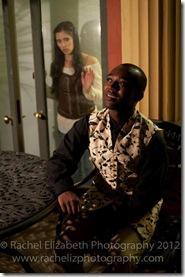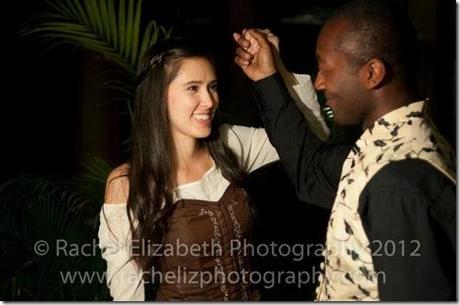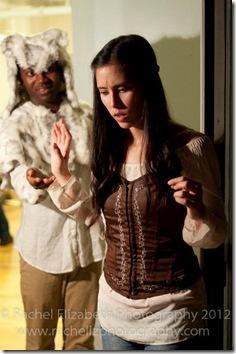
East of the Sun
West of the Moon ,
By Lydia Gordon and Christopher Dunn-Rankin
Directed by K. Hannah Friedman
at Heartland Studio, 7016 N. Glenwood (map)
thru Sept 9 | tickets: $15-$25 | more info
Check for half-price tickets
Read entire review
Though musically strong, production a confusion of mythological and contemporary storytelling

Coriolis Theater presents
East of the Sun, West of the Moon
Review by J.H.Palmer
Coriolis Theater Company, a brand new venture, has launched its inaugural season with an original musical based on the Norse fairy tale of the same name with liberal sprinklings of Greek and Roman mythology mixed in for good measure, including the presence of the three fates (Freda Humble, Allison Kochanski, and Junnie Cross) who spin the threads of time on a series of hooks at the back of the stage (or they try to – the action comes across more like a nervous tic that they perform while waiting for their next lines.)
 The story begins with Asjborn (Travis Austin Wright) declaring to The Queen (Alima Belconis) that, although he has been betrothed to The Princess (Jessica Kahkoska) for most of his life, he is not in love with her and does not wish to go through with the marriage. The Queen makes a deal with him: if he lives a year of his life as a bear during daylight hours and as a man during the night, and manages to find a woman who will love him despite his daylight appearance, he will be free to break from the prearranged marriage. When Asjborn tells The Princess of his new plans, she seems remarkably unphased.
The story begins with Asjborn (Travis Austin Wright) declaring to The Queen (Alima Belconis) that, although he has been betrothed to The Princess (Jessica Kahkoska) for most of his life, he is not in love with her and does not wish to go through with the marriage. The Queen makes a deal with him: if he lives a year of his life as a bear during daylight hours and as a man during the night, and manages to find a woman who will love him despite his daylight appearance, he will be free to break from the prearranged marriage. When Asjborn tells The Princess of his new plans, she seems remarkably unphased.
We then meets Freja (Rochelle Therrien) a young woman who lives with The Father (Raymon Cunha) a widowed man who drinks too much and makes questionable comments to his daughter. Asjborn, as the bear (signified by a kind of bear hat), manages to convince Freja with minimal conversation that he is there to save her from her father. He then asks if she’d like to meet the prince, and when she does, explains to her that they can only meet in the dark.
What follows is a somewhat convoluted mix of music and drama. The music is the strongest element in this piece, and the actors have good voices. Some of the best lyrics come in the song “Starlight,” when Asbjorn sings to his true love, Freja: “You in the starlight have a certain kind of charm" (but these words led me to wonder how he found Freja, and what made him fall for her).
The costuming for Asbjorn and Freja is the simplest and the most effective. By contrast, the rest of the cast’s costuming seems overwrought and at times comical. The crowns worn by The Queen and The Princess look like metallic g-strings mistakenly worn on their heads, reminding me of Princess Leia’s metallic undergarments when she was shackled to Jabba the Hut. The Three Fates are lost in a sea of gauze, and The Queen wears an inexplicable combination of corsetry and Devon Street fashion.
Act II brings more Greek Mythology to the mix with the introduction of the story of Cupid & Psyche, and the dialogue becomes more dissonant than ever with a blend of mythological storytelling and colloquial speech. The conclusion is predictable and unsatisfying, with a lack of urgency that myth-telling requires.
There are simply too many storylines running at once in this play, and none of them are fully developed. We get bits and pieces of different myths, loosely stitched together with patches of modern speech. To get a better handle on the intention behind this I looked to Literary Manager Julia Rohed’s interview with playwright Lydia Gordon included in the playbill:
Julia Rohed: Why this story? Why work with an adaptation rather than create something entirely original?
Lydia Gordon: Given the themes at the center of the play, I actually felt that building something entirely from scratch would actively work counter to what I was trying to achieve. Ultimately this show is about the importance of paying attention to our common cultural heritage; simultaneously (sic) drawing and breaking ties between tropes creates a single story from many, hopefully one that feels more relevant than any of its stand-alone sources.
JR: And what is the relevance of this story today?
LG: Ideally, that answer would be a highly personal one and I would be loathe for my answer here to effect anyone’s takeaway from this show. All I can give you, therefore, is my highly personal answer. In this day of science and facts, emotions and personal experiences are often relegated to the realm of the “soft” and “unimportant.” But they are actually of the utmost importance. It is when we feel unheard – when we feel that our stories do not matter – that we lash out and make the largest noise that we can comprehend. And that is what so often ends in tragedy.
This two-question interview doesn’t shed much light, other than to confirm my suspicion that this is a mash-up of several stories. East of the Sun, West of the Moon plays out like a first draft, and with enough editing and work could be brought to fruition. As it stands, it’s too long and too disjointed to come together cohesively.
Rating: ★½
East of the Sun, West of the Moon continues through September 9th at Heartland Studio, 7016 N. Glenwood (map), with performances Thursdays and Fridays at 8pm, Saturdays at 6 and 9pm, Sundays 3pm. Tickets are $15-$25, and are available online through BrownPaperTickets.com (check for half-price tickets at Goldstar.com). More information at CoriolisTheater.org. (Running time: 2 hours, includes an intermission)

Photos by Rachel Elizabeth Photography
artists
cast
Rochelle Therrien (Freja); Travis Austin Wright (Åsbjorn); Jessica Kahkoska (The Princess); Alima Belconis (The Queen); Raymon Cunha (The Father, The Four Winds); Freda Humble (The Past); Allison Kochanski (The Present); Junnie Cross (The Future); Perrine Iannacchione
behind the scenes
K. Hannah Friedman (director); Danielle Stack (stage manager); Geoffrey Bleeker (production manager); Jenniffer Thusing, Robert Groth (set); Skye Geerts, Yana Atim (costumes); Claire Sangster (lighting); Rachel Elizabeth Photography (photos)
12-0818

